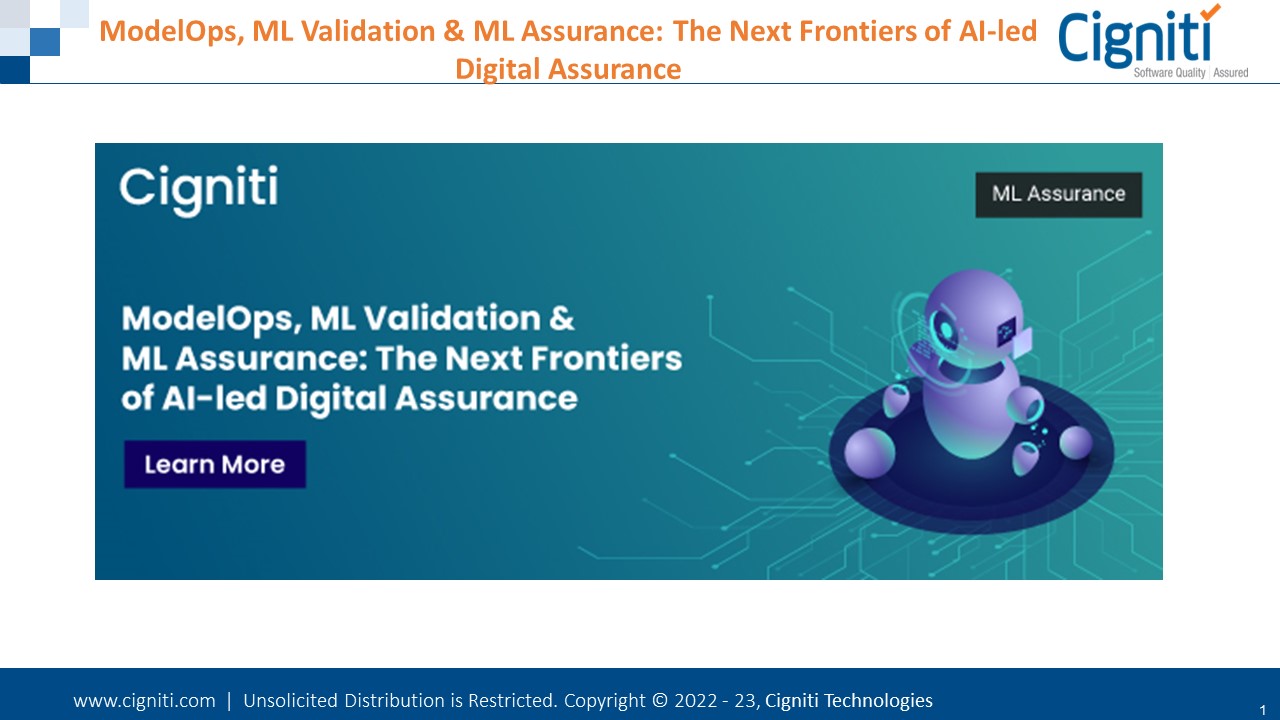Webinar: ModelOps, ML Assurance, ML Validation - PowerPoint PPT Presentation
Title:
Webinar: ModelOps, ML Assurance, ML Validation
Description:
outcome of new data. On some natural language problems, ML models have even surpassed human performance. But much like people, ML models are susceptible to error. For every ML application in the real world, estimating how frequently a model will be inaccurate is essential. Intuitively presenting information and emphasizing the best ways to enhance a model are equally important. – PowerPoint PPT presentation
Number of Views:2
Title: Webinar: ModelOps, ML Assurance, ML Validation
1
ModelOps, ML Validation ML Assurance The Next
Frontiers of AI-led Digital Assurance
2
ModelOps, ML Validation ML Assurance The Next
Frontiers of AI-led Digital Assurance
Like humans, Machine Learning (ML) models can
recognize intricate patterns and anticipate the
outcome of new data. On some natural language
problems, ML models have even surpassed human
performance. But much like people, ML models are
susceptible to error. For every ML application in
the real world, estimating how frequently a model
will be inaccurate is essential. Intuitively
presenting information and emphasizing the best
ways to enhance a model are equally
important. According to Gartner, only 53 of ML
models get from prototype to production. The
sentence may alternatively be expressed as
follows 47 of ML initiatives fail to enter
production. There is a good likelihood that a
machine learning solution will not be
successfully implemented if an organization sets
out to do so. For those models that do make it to
production, it takes at least three months to get
ready for deployment. A real operational
expenditure and a longer time to value are the
results of the increased time and labor. Why do
ML models fail? Every data scientist has
experienced a circumstance when they believed a
machine learning model would be excellent at
making a prediction, but when it was put into
use, it didn't work as well as anticipated. In
the best-case scenario, this is just a
time-wasting inconvenience. However, in the worst
situation, unexpected performance from a model
might cost millions of dollars or even human
lives. Setting wrong expectations The project's
stakeholders may have high expectations for ML
models when it first gets underway. However, if
the goals and the machine learning model being
developed are not in line, issues may occur.
Technology is not magic. Everything is designed
to function with the situation at hand as the
objective. No amount of data analysis and
modeling effort can ensure the project's success
if there are no clearly defined objectives and an
issue that must be solved.
3
ModelOps, ML Validation ML Assurance The Next
Frontiers of AI-led Digital Assurance
Compromising the quality of data The quality of
machine learning models depends on the quality of
the data. For instance, if we train a model to
recognize bananas from an image, but our data
only contains images of apples, the model will
not be able to recognize bananas. Even if we
obtain the most pertinent data for the issue,
most of our time is still devoted to data quality
and purification tasks. The quality criteria for
the data needed to train a machine learning model
are high. Low-quality data provided during
training would produce a poor model, which would
also produce incorrect predictions. Against this
backdrop, join us for an insightful digital
dialogue series where Cignitis thought leaders
give you an in-depth look at ML validation and ML
assurance. AI-led digital assurance is extremely
important for any digital transformation
programs success. The bedrock of becoming
digital-first in modern-day business is ensuring
impeccable digital experiences, and customers
today are looking to leverage this expertise
further. Join Srinivas Atreya, Chief Data
Scientist at RoundSqr (Part of Cigniti), Kiran
Kuchimanchi, Chief Executive Officer at RoundSqr
(Part of Cigniti), and Sairam Vedam, Chief
Marketing Officer at Cigniti as they share
insights on the best practices of ModelOps, ML
Validation, and ML Assurance. Interesting
right? Want to know more on this topic
https//bit.ly/3B2rU66
4































